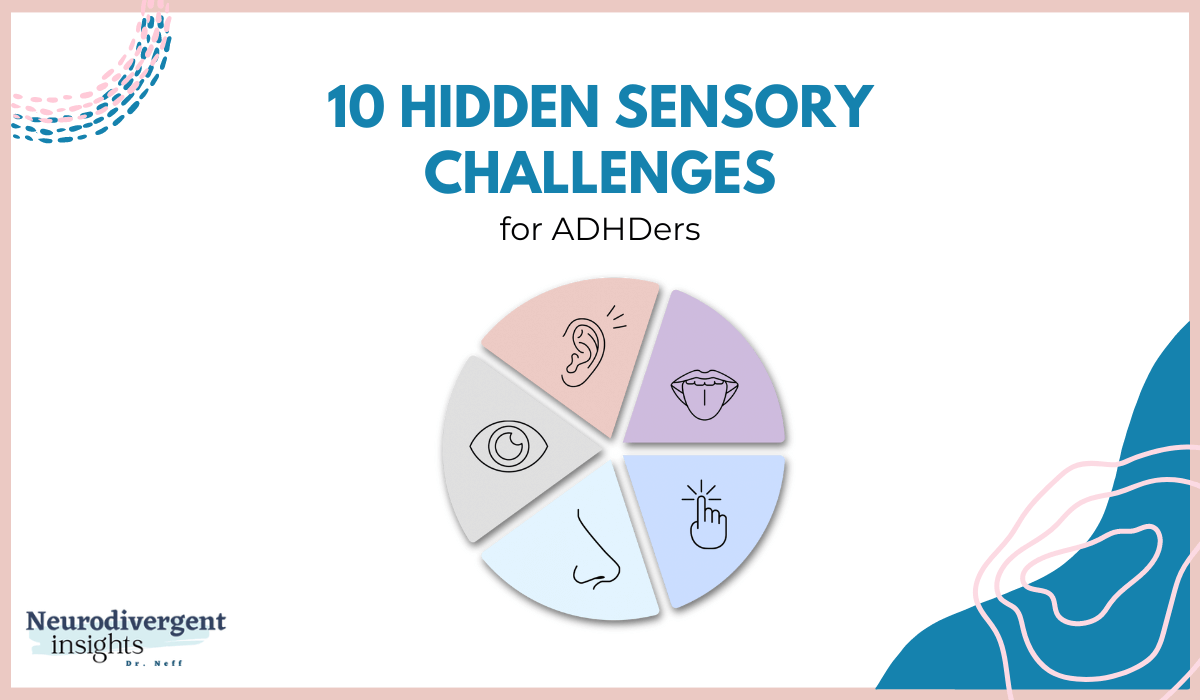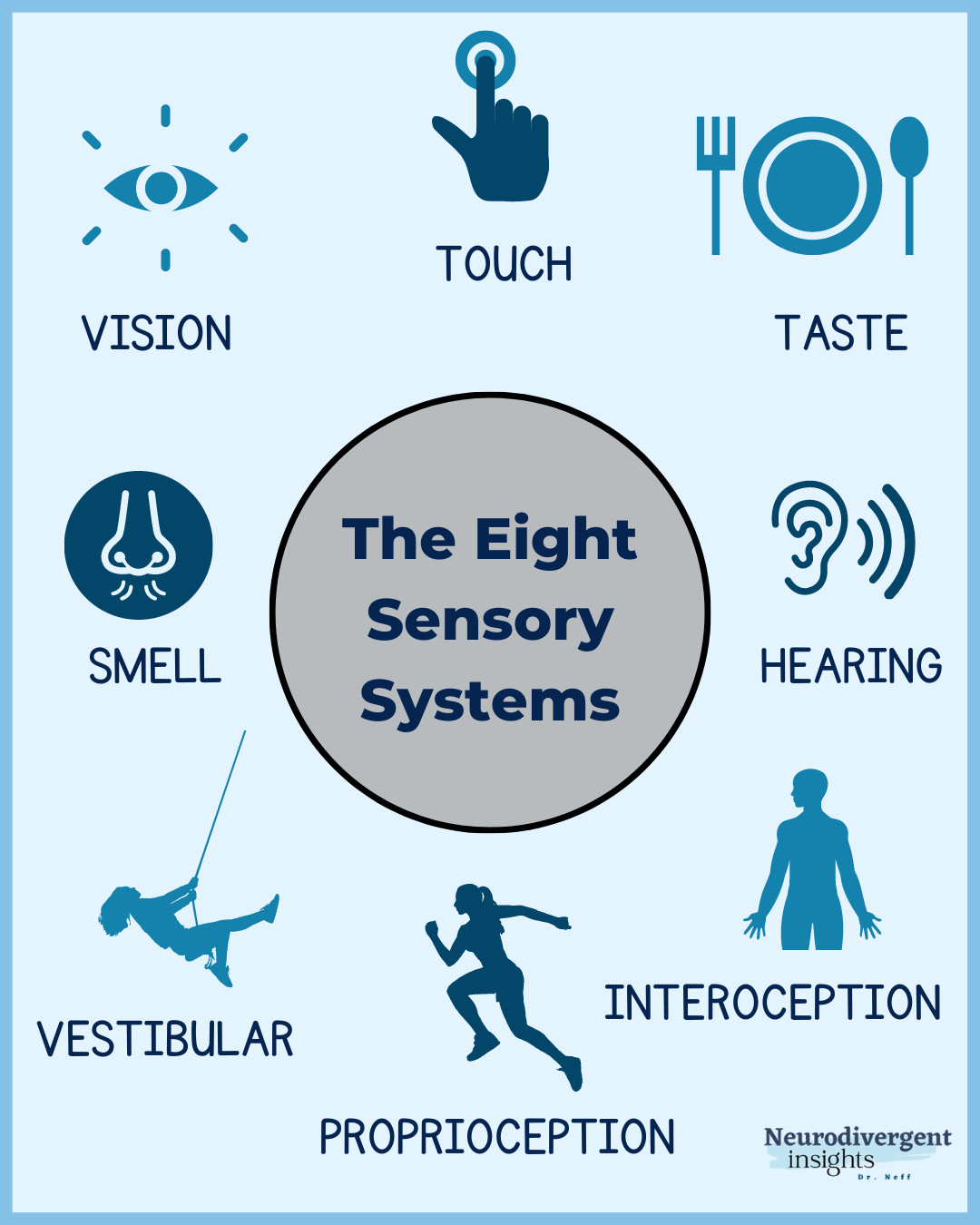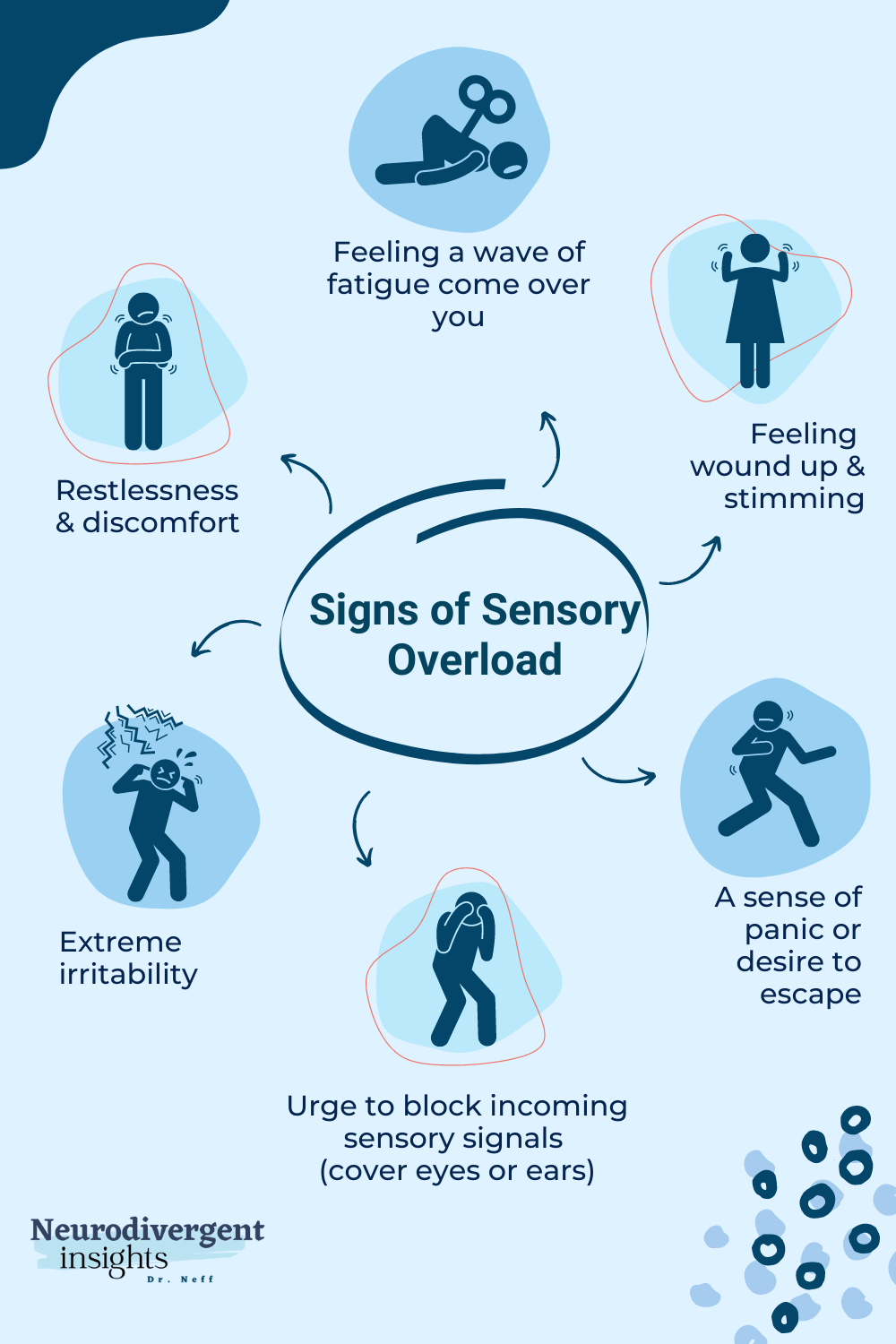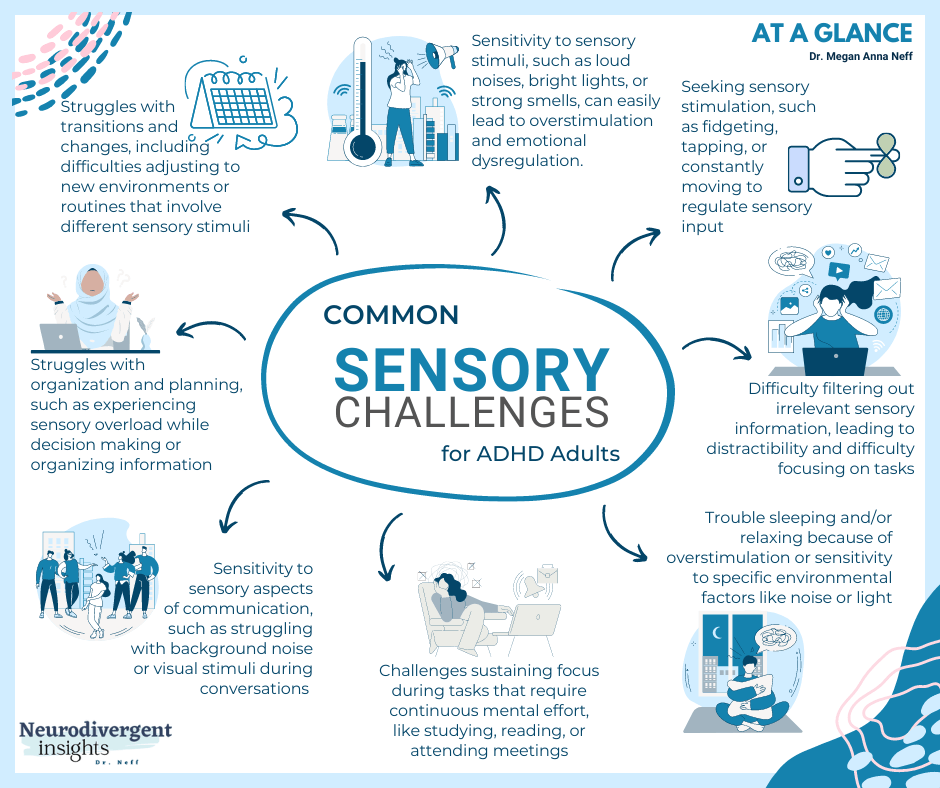The Unexpected Consequences of Sensory Overload in ADHD: 10 Hidden Impacts
In our daily lives, the world bombards us with bustling environments, vibrant sights, and cascading sounds. For some of us, especially those of us with ADHD (Attention Deficit Hyperactivity Disorder), these everyday experiences can quickly become overwhelming! When one or more senses become inundated, our brains struggle to cope with the flood of information. From energetic restaurants to crowded grocery stores, even a single loud sound or a bright light can tip the scales, leaving us stressed and uncomfortable.
I gained a new appreciation for my sensory processing challenges when I learned about my neurodivergence at the age of 37. Before developing a sensory lens, I thought everyone felt overwhelmed in places like restaurants, grocery stores, movie theaters, or crowded rooms!
When I first got interested in this topic, I delved into internet research to better understand my experiences, only to find images of small boys with fidgets and weighted vests. While this was helpful for my parenting, I longed for guidance on navigating sensory issues as an adult. While sensory processing disorder can impact children and adults alike, much of the research and tools is geared toward children.
In this mini-series on sensory regulation, I'll share information and strategies drawn from my personal experience as an adult with sensory processing issues and as a clinical psychologist. In today’s article, we will explore sensory processing difficulties and specifically look at common symptoms of sensory overload, ADHD adults, and sensory sensitivities (next week, I'll take a closer look at Autistic Adults). We will delve into everyday sensory experiences ADHDers may experience and explore some hidden ways sensory processing differences can impact us.
What is Sensory Processing Disorder?
Sensory processing disorder or SPD is when the brain has trouble receiving and responding to information that comes in through the senses. SPD can impact kids and adults alike. Symptoms might include difficulties processing and regulating sensory input such as touch, sound, taste, smell, and visual stimuli. This can result in us becoming more easily overwhelmed by sensory input. People with sensory processing disorder may exhibit over or under-sensitive reactions to sensory input, which can interfere with daily life tasks and cause distress.
Between 5-15% of people have a sensory processing disorder, which is more common in people with ADHD (Miller et al., 2017). Our brain's processing style makes us more vulnerable to sensory processing problems and sensory processing disorders. People with ADHD may be more sensitive to our sensory environment meaning sensory overload is common for us.
As someone with sensory processing disabilities, I have firsthand experience of the disruption sensory sensitivities create. Once I was diagnosed with ADHD, I began understanding my sensory profile, and I learned to work with it for the first time. I created accommodations to support my auditory, visual, and tactile sensitivities and was able to communicate better with my family and friends about my sensory needs. Those of us with sensory differences must be vigilant about getting the support we need to avoid perpetual burnout cycles!
What is Sensory Overload?
People with sensory processing differences are more prone to experience sensory overload. Sensory overload occurs when our sensory systems become bombarded with more input than they can effectively process. For example, let’s look at the sensory experience of a restaurant. When we enter the restaurant, we step into a busy restaurant filled with the chatter of people, clinking of dishes, and a medley of aromas - all while the lights flicker and music plays in the background. In such situations, our brains grapple with an excessive influx of sensory data, resulting in discomfort and stress. The intensity of these feelings can vary from mild to severe, depending on the individual and the environment.
Sensory overwhelm manifests differently in each person. Some may experience heightened sensory sensitivity, feeling overwhelmed by subtle stimuli, while others might become irritable or agitated in crowded spaces. The ability to concentrate may diminish significantly when faced with a sensory deluge, hindering decision-making and organizational skills. Common triggers include crowded spaces, noisy environments, itchy or rough fabrics, too much cognitive input all at once, bright lights, or strong smells.
The Five Senses (Plus Three Hidden Ones)
There are several different types of sensory input and different types of sensory information. We have eight primary sensory systems, including:
Visual system: This system includes the eyes and helps us perceive and interpret light and color. It enables us to see and recognize objects, shapes, and movements.
Auditory system: This system includes the ears and helps us perceive and interpret sound. It allows us to hear and differentiate between different pitches, volumes, and tones.
Olfactory system: This system includes the nose and helps us perceive and interpret smells. It enables us to detect and recognize various scents.
Gustatory system: This system includes the taste buds in the tongue and helps us perceive and interpret taste. It allows us to distinguish between different flavors such as sweet, sour, bitter, and salty.
Tactile system: This system includes the skin and helps us perceive and interpret touch and pressure. It enables us to feel different textures, temperatures, and levels of pressure applied to our bodies.
Vestibular system: This system includes the inner ear and helps us perceive and interpret our body's position, balance, and movement in space. It allows us to maintain balance and coordination.
Proprioceptive system: This system includes receptors in our muscles, tendons, and joints and helps us perceive and interpret body position, movement, and force. It enables us to have a sense of where our body parts are in relation to each other and the effort required to perform actions.
Interoceptive system: This system includes receptors in internal organs and helps us perceive and interpret internal bodily sensations such as hunger, thirst, pain, temperature, and emotions. It enables us to recognize and respond to our physiological needs and emotional states.
Many adults with ADHD have sensory differences in how their brain processes sensory input in any or all of these senses, and overload occurs when the brain is inundated with too much sensory information and lead to sensory overload. This is because the ADHD brain tends to process sensory information differently and often struggles to block out certain sensory inputs, resulting in atypical sensory profiles.
When a person has differences in how their brain processes information, it could be over-responsive or under-responsive. Sensory over-responsivity is marked by a heightened experience of sensory information. For example, I am over-responsive in my olfactory, hearing, and tactile. And smells that others barely register can trigger an instant migraine for me! (Note, I attribute the intensity of my olfactory sensitivities more to my autism than my ADHD, but such experiences can also happen for ADHDers.) Overload is common for people with hypersensitive sensory systems. Other people experience sensory under-responsivity which means it takes more signals for their brains to register the sensory signal. These folks tend to be more sensory seeking and need more input to register their sensory environment.
Understanding Sensory Overload in Adult ADHD
Sensory overload happens when any one of the senses (or multiple) becomes overwhelmed. When in busy environments, we may have competing sensory information coming at us that can cause sensory overwhelm, resulting in what is called sensory meltdown or sensory shutdown.
Although sensory overload can affect anyone occasionally, it is more common for people with ADHD. The relentless sensory bombardments can significantly impact our day-to-day lives, making routine tasks exhausting, challenging, and daunting.
10 Signs of Sensory Overload in Adults
If you are wondering if you may have sensory sensitivities, here are ten symptoms of sensory overload in adults. People with sensory overload may experience these signs and symptoms:
Heightened sensitivity to certain sounds, such as loud noises, background noise, or specific frequencies. This may lead to difficulty focusing, concentrating, or maintaining attention due to excessive sensory input and difficulty filtering out background sensory input.
Discomfort or distress in environments with bright or flickering lights
Difficulty focusing or concentrating when there are multiple stimuli or distractions present
Feeling overwhelmed or agitated in crowded or busy places or feeling overwhelmed, anxious, or stressed may result in an extreme response called a sensory meltdown.
Avoidance or aversion to certain textures or fabrics when it comes to clothing or touch
Irritation or distress from certain smells or strong odors (perfumes, cleaning supplies, specific foods, etc.)
Feeling physically uncomfortable or easily overwhelmed by certain tastes or food textures
Persistent exhaustion or fatigue from the constant processing of sensory input. Complicating fatigue struggles — sensory overwhelm can lead to insomnia and restless sleep
Increased irritability, restlessness, agitation, or anxiety in overwhelming sensory environments. Emotional reactions may range from irritability and frustration to feeling emotionally drained or overwhelmed.
Experiencing physical symptoms such as headaches, fatigue, muscle tension, dizziness, or nausea in response to sensory-rich environments
Sensory shutdowns and meltdowns can manifest differently for each person, and being attuned to our specific signs is key to understanding how to intervene and help manage our sensory experiences.
ADHD Sensory Overload in Adults
Sensory overload and ADHD often walk hand in hand. Many people with ADHD may experience sensory overload. When you have ADHD, it doesn't take much to trigger sensory overload, which can result in feeling overwhelmed, restless, or easily overstimulated. Complicating matters when overloaded this adds a layer of stress to our already strained sensory experiences and executive functioning struggles. Sensory overwhelm amplifies our existing challenge. The constant bombardment of sensory stimuli can easily overwhelm our already heightened sensory system, leading to difficulty focusing, increased distractibility, and restlessness.
Additionally, many people with ADHD are drawn to novel and stimulating environments, which presents a unique challenge. While these settings can be exciting and engaging, they might also lead to sensory and emotional exhaustion, necessitating longer recovery periods. This duality underscores the importance of balancing our need for stimulation with our capacity for sensory processing. Recognizing when to seek excitement and when to retreat and recover is key to managing sensory overload in ADHD.
ADHD and Sensory Overload: 10 Manifestations
While often not recognized, our sensory experiences impact nearly every aspect of our day-to-day lives, from getting up to get a glass of water to walking to work or engaging in a conversation with a friend. While obvious signs of sensory overwhelm, like being bothered by loud sounds and certain textures, are more apparent, there are subtler ways that a person with ADHD may be impacted by sensory issues.
The intersection of sensory experiences with daily tasks, such as task-switching, organization, and routine changes, often goes unnoticed. Here are ten ways that sensory sensitivities can impact adults with ADHD:
1. Environmental Sensitivity and Difficulty Filtering Sensory Information:
Because we tend to be highly sensitive to sensory stimuli in our surroundings, loud noises, bright lights, or strong smells can easily overwhelm or overstimulate us and cause sensory overload. This heightened sensitivity can pose challenges in managing everyday activities, such as navigating busy grocery stores, classrooms with various scents, or crowded spaces.
It can also make initiating tasks in such stimulating environments more difficult for us. Task switching, a common struggle for many with ADHD, becomes even more challenging when transitioning into tasks involving unpleasant sensory experiences. For instance, I personally find task-switching out of the shower particularly difficult. The sensory comfort of warm water abruptly shifts to the sensation of cold air, and multiple tasks lie ahead in preparing for the day, which can be overwhelming.
Furthermore, difficulty filtering sensory information adds to our distractibility. Adults with ADHD often find it challenging to filter out irrelevant sensory stimuli, intensifying struggles with concentration and focus. This difficulty can hinder us from getting into a flow state during projects or tasks, as we may get easily derailed by surrounding sensory input. Staying focused in conversations can also become problematic when competing sensory stimuli capture our attention, leading to misunderstandings or difficulties in fully engaging in discussions. Understanding the impact of environmental sensitivity and sensory filtering challenges is essential in finding strategies to navigate these sensory experiences.
2. Sensory Aspects of Time Management:
While it is well known that many people with ADHD have trouble with time blindness and time perception, the role of sensory processing in this aspect is less recognized. Sensory overload can significantly impact how we estimate the passage of time. When experiencing sensory overwhelm, our brain's ability to accurately gauge time may be affected. The overwhelming sensory input diverts our attention and distorts our perception of time passing, making it difficult to stay on schedule.
Moreover, sensory overload can lead us to seek sensory stimulation or engage in sensory-rich activities as a coping mechanism. By becoming hyperfocused on a sensory-rich experience, such as watching videos or playing video games, we may lose track of time in the process. This can further exacerbate our challenges with time management, as we might become absorbed in these activities and neglect other responsibilities or commitments.
3. Planning Motor Movement:
Planning our movements in space, which includes sequencing the steps we will take and coordinating balance and steps, relies on several sensory systems, with proprioception and vestibular senses being among the primary ones. When we experience difficulty with these sensory systems, it can make planning motor movements more challenging. Even seemingly simple tasks, like moving our computer to a different spot, grabbing two glasses, and walking over to the sink to fill a cup, can become more complex due to difficulties in sensory processing.
In addition to sensory challenges, executive functioning issues can further complicate breaking tasks down into manageable steps. These challenges can overlap and interact in ways that make planning even the simplest motor movements a daunting task. The interplay between sensory difficulties and executive functioning can hinder our ability to plan and execute physical actions smoothly and efficiently.
4. Seeking Sensory Stimulation:
To regulate sensory input, we often seek out stimming. This can look like fidgeting, tapping, or constant movement. Stimming helps to manage our sensory experience as it provides us with repetitive sensory input that is within our control. People tend to know that adults with ADHD fidget a lot, but often there isn’t a recognition of why we fidget. In addition to releasing built-up energy, we are also helping to regulate our sensory input by stimming and intentionally creating sensory input for ourselves through fidgeting.
When we are in positions where we are expected to sit still (like work meetings), this can make it difficult to stay sensory-regulated. The pain point in this is that these are times when we are often working really hard to maintain our focus and attention, and a bit of stimming would go a long way in helping us to focus and stay sensory-regulated!
5. Challenges with Organization and Planning
ADHD makes things like organizing and planning out tasks more difficult. Sensory overload can further complicate decision-making, planning, and organizing. This can lead to even greater cognitive distractions and interfere with focus and attention during the decision-making process. For instance, trying to make important decisions in a noisy or chaotic environment can make it challenging to think clearly and weigh the options objectively and resulting in emotional overwhelm. This can lead to difficulty in making well-informed choices, potentially causing indecision or impulsivity in some cases.
Additionally, when organizing information, such as planning tasks or setting goals, sensory overload can hinder the ability to structure thoughts coherently. The overwhelming sensory input may disrupt our cognitive processing, making it difficult to break down complex tasks into manageable steps or prioritize activities.
6. Communication Sensitivity
Communication struggles are a lesser-known aspect of ADHD that can lead to a host of social mishaps and misunderstandings. During conversations, we may find ourselves easily distracted and have trouble paying attention. Difficulty focusing may cause us to miss subtle social signals dropped by the other person, potentially leading to misunderstandings in relationships. Sensory processing also plays a crucial role in communication and can further strain these challenges.
Troubles filtering out background noise during conversations or becoming easily distracted by visual or auditory stimuli can have a significant impact on our communication and social experiences. It becomes more challenging to focus on the conversation at hand or to hear everything that others say. Unfortunately, when people don't understand ADHD or aren't aware of our ADHD traits, they might mistakenly interpret these behaviors as signs of disrespect or disinterest. As a result, the difficulties related to sensory processing in communication can add extra hurdles to our social interactions as individuals with ADHD.
7. Maintaining Focus and Attention
Sensory difficulties can also intensify our struggles with maintaining focus and attention. As ADHDers, we already have difficulty regulating attention, and when sensory overwhelm is thrown into the mix, it becomes much more challenging! Sensory overload can make it difficult for us to sustain mental focus during various activities, such as studying, reading, or attending meetings. The constant barrage of sensory input can lead to frequent distractions and make it challenging to stay engaged and attentive to the task at hand.
8. Transitions and Changes
Transitions and changes can be particularly challenging for individuals experiencing sensory sensitivities. When we are already overloaded with sensory input, adjusting to new environments or routines that involve different sensory stimuli can be overwhelming. The introduction of new smells, textures, sounds, or routines can create an additional sensory load, making the transition even more difficult to navigate. As a result, we may feel a heightened sense of overwhelm during these times of change, and it may take us longer to adapt and find our balance in the new environment or situation.
9. Emotional Regulation
Emotion regulation is often a core symptom of ADHD (due to brain connectivity differences). However, when sensory overload is added on top of that, managing emotional responses becomes even more challenging! The overwhelming sensory input can intensify our emotional reactions, making it harder to regulate our feelings effectively. Moreover, we may encounter difficulties with some sensory aspects of calming and self-soothing techniques. For example, engaging in deep breathing might be challenging due to interoception struggles that make it more difficult to perceive our breath, affecting our ability to use this common relaxation method. As a result, navigating our emotions can become a complex task, requiring us to find alternative strategies that align with our sensory needs.
10. Sleep and Relaxation Challenges
ADHDers are known for being poor sleepers due to a host of reasons, including flattened melatonin curves, circadian rhythm disorders, sleep apnea, and more. Sensory overstimulation to environmental factors like noise or light can further compound our difficulties in winding down and relaxing before bedtime. After a day filled with sensory overload, it may be challenging to fully release the accumulated energy and unwind, making it difficult to fall asleep. As a result, sleep and relaxation can become significant challenges for adults with ADHD, impacting our day-to-day life and overall well-being. Finding strategies to manage sensory input and create a calming bedtime routine that helps us down-regulate our nervous system is essential in improving our sleep quality!
Coping with Sensory Overload As An Adult
Navigating sensory issues as adults with ADHD presents unique challenges and opportunities compared to children with ADHD. Coping with sensory issues in adulthood involves cultivating a mindful mindset, recognizing our sensory limitations, and taking purposeful actions to foster sensory safety.
Sensory overload cannot be avoided completely, but there are strategies and techniques that can help manage and reduce its impact. Some tips for managing sensory overload include:
1. Identify Triggers: Recognize what environments, situations, or stimuli tend to overwhelm your senses. By understanding our specific sensory triggers, we can develop strategies to manage these triggers better. You can start by reviewing a sensory trigger checklist to get you started.
2. Plan ahead: When possible, plan ahead and be prepared for potentially overwhelming situations. This might include bringing earplugs or noise-canceling headphones to crowded places or having a quiet space to retreat to when needed.
3. Take breaks: Give yourself regular breaks throughout the day to rest and recharge. I like to refer to these sensory breaks as my “sensory detox” time.”
4. Implement sensory accommodations: Use tools or techniques that can reduce sensory input or help regulate sensory input. This might include using weighted blankets, fidget toys, or noise-canceling headphones. See this list of sensory tools for ideas on different sensory accommodations to try (disclosure affiliate links).
5. Practice relaxation techniques: Engage in relaxation techniques such as deep breathing exercises or other exercises that help down-regulate the nervous system and can help to quiet and calm the nervous system.
6. Establish boundaries: Communicate your needs and limits to others. Set boundaries and ask for support when necessary. By understanding your sensory limits and creating boundaries to honor them, you can better advocate for yourself.
7. Create a sensory-friendly environment: Adjust your environment to be more sensory-friendly. This might include minimizing clutter, using soft lighting, or playing calming music. Consider starting with identifying your sensory preferences as part of this process.
8. Utilize sensory diets: A sensory diet (I prefer the term sensory safety plan) is a personalized plan that incorporates specific sensory activities throughout the day to regulate and balance sensory input. Check out this post to learn more about sensory diets.
9. ADHD Coaching: As discussed above, the intersection of executive functioning challenges, ADHD symptoms, and the impact of sensory processing differences have a complex relationship! When we are cognitively overloaded, this intensifies sensory overload! For this reason, working with an ADHD coach can help you create systems and strategies for managing ADHD overwhelm and will also help with sensory processing struggles.
10. Sensory Play: Play! Whether it's with sensory toys or experimenting with new sensory experiences (kinetic sand, fidgets, etc.). When you find satisfying sensory experiences, these can be powerful tools for helping you to manage your sensory experiences better.
11. Consider working with a sensory-based occupational therapist: An occupational therapist may recommend sensory integration therapy to improve your brain's processing of sensory input. Additionally, you may learn strategies for working with your sensory profile. An OT can provide you with information about the treatment for sensory overload and processing disorder and can help you manage sensory processing disorder and your sensory experiences better.
Finding what works best for you may involve trial and error, so it takes a bit of play and patience! Learning to manage our sensory regulation plays a key role in our emotional self-regulation!
Conclusion
So, to bring it all together and summarize — managing sensory issues as an adult is a journey of self-discovery and intentional action. By acknowledging our sensory struggles and sensory limits, we can navigate the challenges of sensory overwhelm with greater resilience and agency.
You can check out the rest of this sensory regulation series for more tips on how to work with your sensory profile and create a sensory safety plan; if you're looking for more guidance and practical tools to cultivate sensory safety, you can check out the Sensory Haven Workbook. This workbook provides step-by-step guidance, exercises, and worksheets to help you develop your sensory safety plan and create a personalized toolkit for managing sensory challenges.











